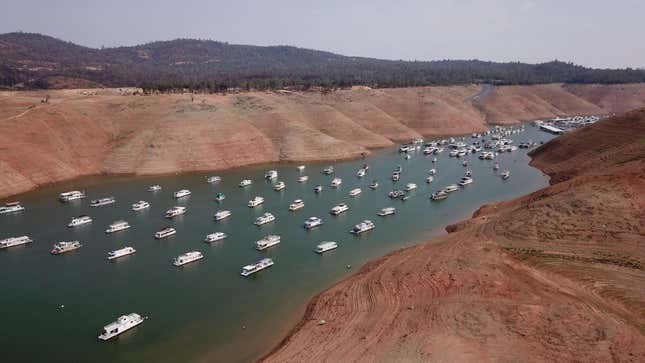
Lake Oroville is the latest reservoir across the West to sink to a new low. The reservoir is getting so empty that a major hydropower plant has had to shut down months ahead of what officials expected in late June, reflecting the worsening situation across the state.
“DWR State Water Project operations managers have taken the Hyatt Powerplant at Lake Oroville offline due to falling lake levels,” Department of Water Resources Director Karla Nemeth said in a statement. “This is the first time Hyatt Powerplant has gone offline as a result of low lake levels.”
State data shows the reservoir sits at just 24% of capacity, lower than at any point since the reservoir was filled in 1967. That includes a dry period in the 1970s as well as the severe drought that hit California in the mid-2010s. The dwindling water supplies mean there’s not enough to get turbines at the hydropower plant to spin and generate electricity. At full capacity, the Hyatt Power Plant can crank out enough juice to power 800,000 homes, according to CNN.
The loss of a key source of hydropower means that California may have to meet more electricity needs using other means, such as natural gas peaker plants. That’s particularly true on days when the heat cranks up and people require more electricity for air conditioning.
Officials began to worry about Lake Oroville in June, right as the drought began to take a deeper toll on water resources in the state and across the West at large. They began prepping to stop power generation when the reservoir level dipped below 640 feet (195 meters), saying that was likely to happen within two to three months. But the day when the dam could no longer generate power came sooner than expected. As of Friday, the lake stood at 641.39 feet (195.5 meters). (And yes, the reservoir level measurements are that specific.)
It’s a pretty shocking turn of events for a reservoir that just four years ago was at risk of blowing out the dam holding it back due to too much water. Heavy winter rains caused major erosion of a spillway, putting the whole dam in danger. Luckily, the worst didn’t come to pass. But climate change has upped the odds of weather whiplash in California between extreme wet and dry years, and the wild swing on display at Lake Oroville all-too-perfectly encapsulates the challenges that whiplash poses.
“This is just one of many unprecedented impacts we are experiencing in California as a result of our climate-induced drought. California and much of the western part of the United States are experiencing the impacts of accelerated climate change including record-low reservoir levels due to dramatically reduced runoff this spring,” Nemeth said.
Similar scenes are playing out across the West. Lake Powell and Lake Mead, the two largest reservoirs in the country, are at record lows. Great Salt Lake? Also a record low. Though it’s not used for drinking water, the lake serves a vital ecological role. Elsewhere, low water levels have led to extremely hot rivers and streams, leading to the death of endangered and threatened salmon across California, Oregon, and Wyoming. (Lake Oroville operators have said they’ll manage water to keep streamflows—and hopefully temperatures—below the dam at reasonable levels.)
The West’s water crisis is one fueled by climate change and made worse by water use in a region where population growth and agriculture have stretched resources to the limits. Something has to give, and it appears that hydropower at Lake Oroville is the first. But it certainly won’t be the last.